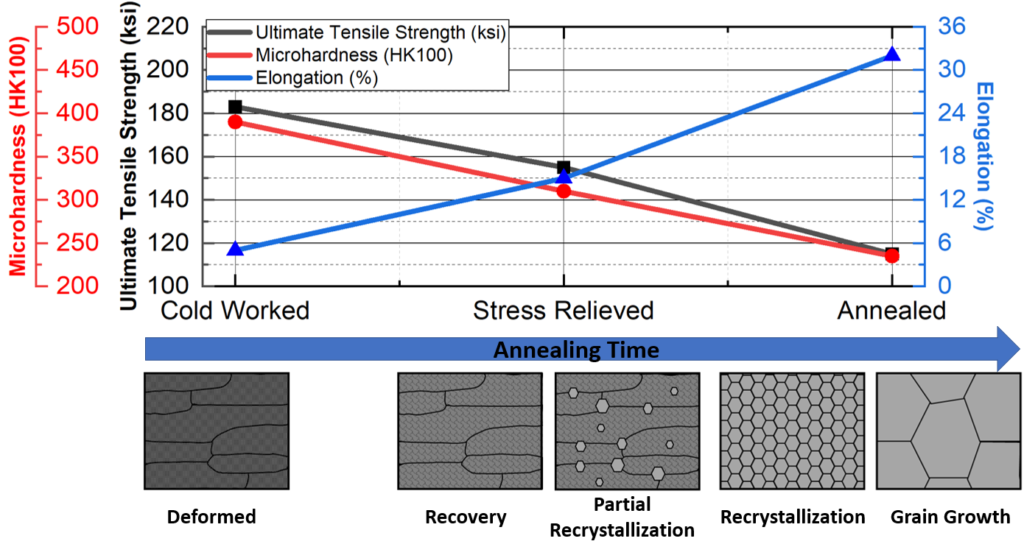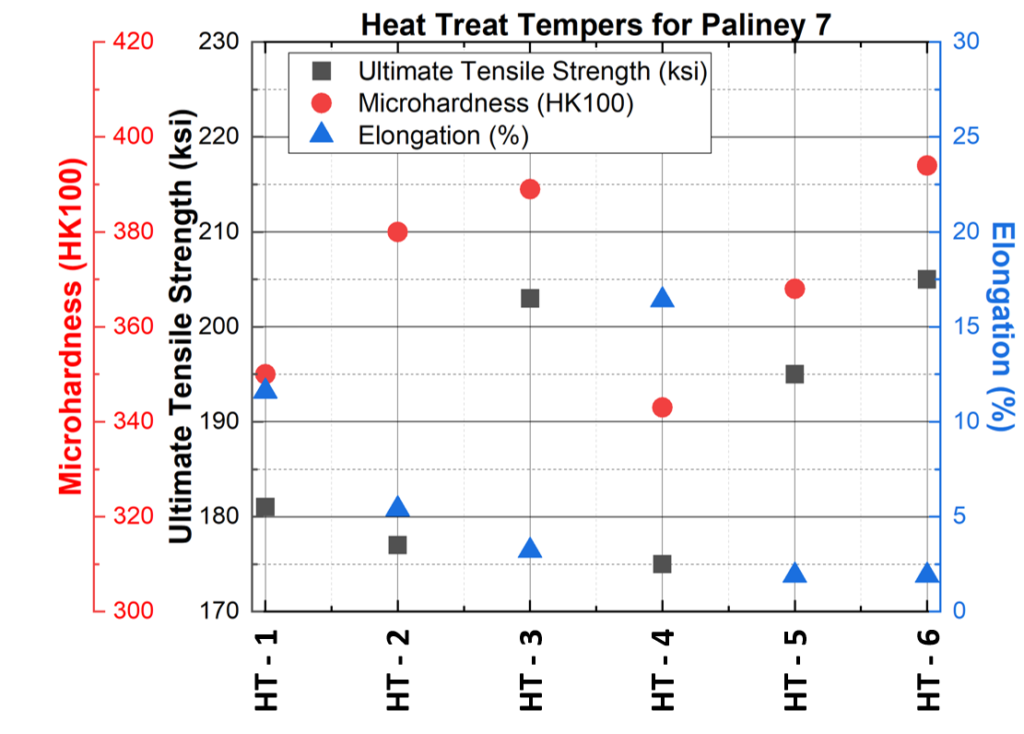Deringer-Ney products are engineered to satisfy a wide array of applications and needs. While each alloy family has its individual strengths, the properties of a single alloy can be tuned according to its temper. The temper describes the condition of the material and is shorthand to describe properties and microstructure.
Cold Worked – Cold working is the process by which metals are deformed through high mechanical stresses such as those caused by large rollers, Figure 1.a), or drawing wire through dies. Cold working introduces dislocations into the metal, and hardness and strength scales with increasing dislocation density¹. As can been seen in Figure 1.b), cold working greatly enhances ultimate tensile strength from the initial undeformed metal. Although the cold worked temper is strong, it lacks ductility and may catastrophically fail under continued mechanical stress. Cold worked material is difficult to shape or process, so metals often receive annealing steps² to recover workability.

Figure 1: a) diagram depicting the effects of cold rolling on microstructure and b) a plot showing the relationship between ultimate tensile strength and area reduction for Paliney 7.
Stress Relieved – The stress relieved temper occurs when a metal is thermally treated with the purpose to relieve stresses caused by cold working. Intermediate temperatures enable facile dislocation migration and dislocations with opposing strain fields are drawn towards each other until both are annihilated. This reduction in dislocation density reduces strength and hardness but also recovers elongation. The remaining dislocations become entangled and minimize their energy by forming an array of overlapping strain fields. This array creates subgrain boundaries, or low-angle grain boundaries, that exist within the deformed grain. This process is also known as recovery and is the first step in the annealing process. Careful application of a stress relief can be used to improve the straightness of wire or the flatness of sheet.
Annealed – The annealed temper occurs further along the annealing process. The recovered microstructure is still out of equilibrium and will begin recrystallizing to minimize internal energy. New dislocation-free grains nucleate and grow until the deformed grains and subgrains have been replaced. As the interface and dislocation density has been drastically reduced, recrystallization is accompanied by a sharp reduction in strength/hardness and an improvement in ductility. If thermal processing continues, then the fine grain structure resulting from recrystallization will begin to coarsen. This stage is known as grain growth; grains will continue to grow and subsume neighboring grains into themselves.
Paliney 7 – Paliney 7® is a Pd based alloy that is commonly used in electrical contacts and, as can be seen in Figure 2, clearly demonstrates the relationship between temper and properties. As the alloy evolves along the annealing process, a clear decrease in strength can be observed caused by the annihilation of cold worked introduced dislocations. Paliney 7 is an age-hardenable material, meaning that after annealing it can be heat treated again.

Figure 2: Plot showing the ultimate tensile strength, microhardness and elongation for the coldworked, stress relieved and annealed tempers. Accompanied of diagrams showing the microstructure for each temper.
Heat Treated – The process of thermally treating a material at an elevated temperature for prolonged times also plays a significant role on properties. Depending on the material involved, heat treating can engender eutectoid decompositions, phase changes, precipitation, etc; this process can also be referred to as “age hardened”. In the case of Paliney 7, heat treating produces a spinodal decomposition3. These solid state phase transformations are all dependent on the initial state of the material, the temperatures used, and the time at elevated temperature. As demonstrated in Figure 3, six different heat treatments (HT) result in a wide range of properties. These heat treated temperatures can reclaim the high hardness of the cold worked temper, while retaining ductility.
Paliney 7 properties, as well as other alloy systems, can be engineered to satisfy the requirements of the customer. Alloy property data sheets containing the property information for Deringer-Ney precious metal alloys and their tempers can be found at https://deringerney.com/products/precious-metal-alloys/.

Figure 3: Plot showing the ultimate tensile strength, microhardness and elongation for different heat treatments for Paliney 7.
References: